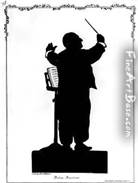- Two Thanksgiving Thoughts for the ACAPosted 10 years ago
- Shop til you Drop at the Healthcare Marketplace Part 2: Frustration!Posted 10 years ago
- An Early Casualty in the Affordable Care FightPosted 10 years ago
- Some Good News for a ChangePosted 10 years ago
Mahleria at the Philharmonic by Curtis Rittenhouse
I looked to see what the local orchestra is offering next week, and one of Mahler’s later symphonies dominates the program. I decided to pass.
I am old enough to recall a time in the early 60’s when Mahler on concert programs was still a rarity. If a Mahler piece was performed, it was likely to be the First, Fourth, or Ninth Symphonies or Das Lied von der Erde. Mahler was unjustly neglected.
Mahler the conductor composer famously said “his time would come” before he died in 1911, and thanks to pioneering work by Bruno Walter, Dimitri Mitropoulos, Jascha Horenstein and of course Leonard Bernstein, it did in a big, big way. Celebrated conductors like Kubelik, Haitink, Chailly, Abbado, Maazel, Tennstedt, Rattle, Bertini, Inbal, Zinman, Sinopoli, Neumann and of course Bernstein recorded entire cycles of his symphonies and other pieces. Most recently The San Francisco Symphony under its musical director Michael Tilson Thomas has completely their own cycle from live performances on their in-house label.
Gustavo Dudamel in Los Angeles this season is offering a cycle within one season this year. Lately it seems like everybody, but the Academy of St. Martin’s in the Fields, is offering us their own thoughts on Mahler. Mahler cycles and festivals are as common these days as tattoos. Mahler’s time has come all right, and it risks outstaying its welcome.
Mahler was a great composer and in his greatest works, his music is second to none. He understood the orchestra of his time and what it could do. When inspired, his music-making transports us. It certainly appeals to those who like what one observer called ‘the big-bow wow’ symphonic experience. No one will deny Mahler’s skills as a composer. But he was also capable of long passages where it feels like inspiration has flagged and he is going through the motions, treading water waiting for it to return.
Long symphonies or movements are tricky. Music was made to be listened to. Even the brightest ideas lose their appeal if they go on and on. The same may be said of long speeches. The best symphonies are those that sense when to move on, like good house guests. Mahler sometimes stays a day or two longer than advisable.
I have heard and read the thinking of many of his ardent admirers. No other composer, with the possible exception of Wagner, provokes such stretches of purple, over-heated prose as Mahler. I think his tortured life, and his OCD personality have a lot of appeal to contemporary listeners. The movie Death in Venice also helped win fans in its time. Conceding that, I do not always see feel I am taken to great vistas and wonderful places in the mind when Mahler is noodling through, say, passages of the Symphony 6. I listen patiently and maybe sneak a look at my watch.
I would plead with American symphony orchestras to give Mahler a well-deserved vacation and look to other worthy symphonies for programming: Bizet’s Symphony in C, Bruckner’s surprising 6th, Chausson’s lone symphony in B flat, Borodin’s magic 2nd, Elgar’s interesting symphonies, a Vaughan Williams cycle for a change, Martinu’s interesting six, Korngold’s sole symphony and my candidate for most unjustly neglected symphony Svendsen’s 1st, a student work with its achingly beautiful slow movement.
Orchestras get breaks, players get vacations. I think its high time Mahler got his.
Curtis Rittenhouse




